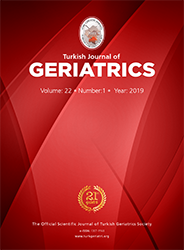2Kafkas University, Faculty of Medicine, Department of Ophthalmology, Kars, Turkey DOI : 10.31086/tjgeri.2019150573 Introduction: The objective of this study is to evaluate indications, outcomes and prognosis in geriatric patients who underwent penetrating keratoplasty (PKP).
Materials and Method: 84 of 297 patients, who underwent PKP between January 2013-August 2016, were retrospectively analyzed. Age, gender, time between the onset of complaints and keratoplasty, duration of follow-up, other intraoperative-postoperative surgical procedures, complications, intraocular pressure (IOP), visual acuity were recorded. The data were statistically analyzed using paired-t test. P<0.05 was considered to be significant.
Results: 84 eyes of 84 patients-49 (58.33%) male, 35(41.67%) female, mean age 65-83 (73.5±10.8) years-were included in the study. PKP was performed due to pseudophakic bullous keratopathy (PBK) in 35 (41.67%) patients, corneal leukoma 27 (32.14%), post-traumatic corneal scar 8 (9.52%), graft failure 6 (7.14%), aphakic bullous keratopathy 5 (5.95%), corneal dystrophy 3 (3.57%). The most common indication was PBK (41.67%). 23 (65.71%) of the PBK patients had posterior chamber intraocular lens (IOL), 10 (28.57%) anterior chamber, 2 (5.71%) scleral fixation. The time between the onset of complaints and keratoplasty was 3-31years. The mean duration of follow-up was 17.7 months. Intraoperatively, extracapsular cataract extraction+IOL implantation was performed on 13 (15.47%) patients, vitrectomy+lens extraction+IOL implantation 8 (9.52%), pupilloplasty 7 (8.33%), anterior chamber IOL extraction+anterior vitrectomy 6 (7.14%). Postoperatively, re-keratoplasty was performed on 9 (10.71%), secondary IOL implantation 8(9.52%), Ahmed glaucoma valve implantation 4 (4.76%), phacoemulsification 3 (3.57%), resuturation 1 (1.19%). Postoperative graft failure was observed in 9 (10.71%) patients, glaucoma 8 (9.52%), cataract 3 (3.57%), endophthalmitis 2 (2.38%), traumatic wound dehiscence 1 (1.19%). Preoperative-postoperative visual acuity was 1.43±0.76, 0.40±0.15 (logMAR), respectively (p<0.01). Preoperative-postoperative IOP was 13.78±6.50 mmHg, 16.01±2.29 mmHg, respectively.
Conclusion: The most prevalent PKP indication in patients aged above 65 years was PBK; the results along with other surgical methods were quite satisfactory.
Keywords : Geriatrics; Keratoplasty, Penetrating; Prognosis
